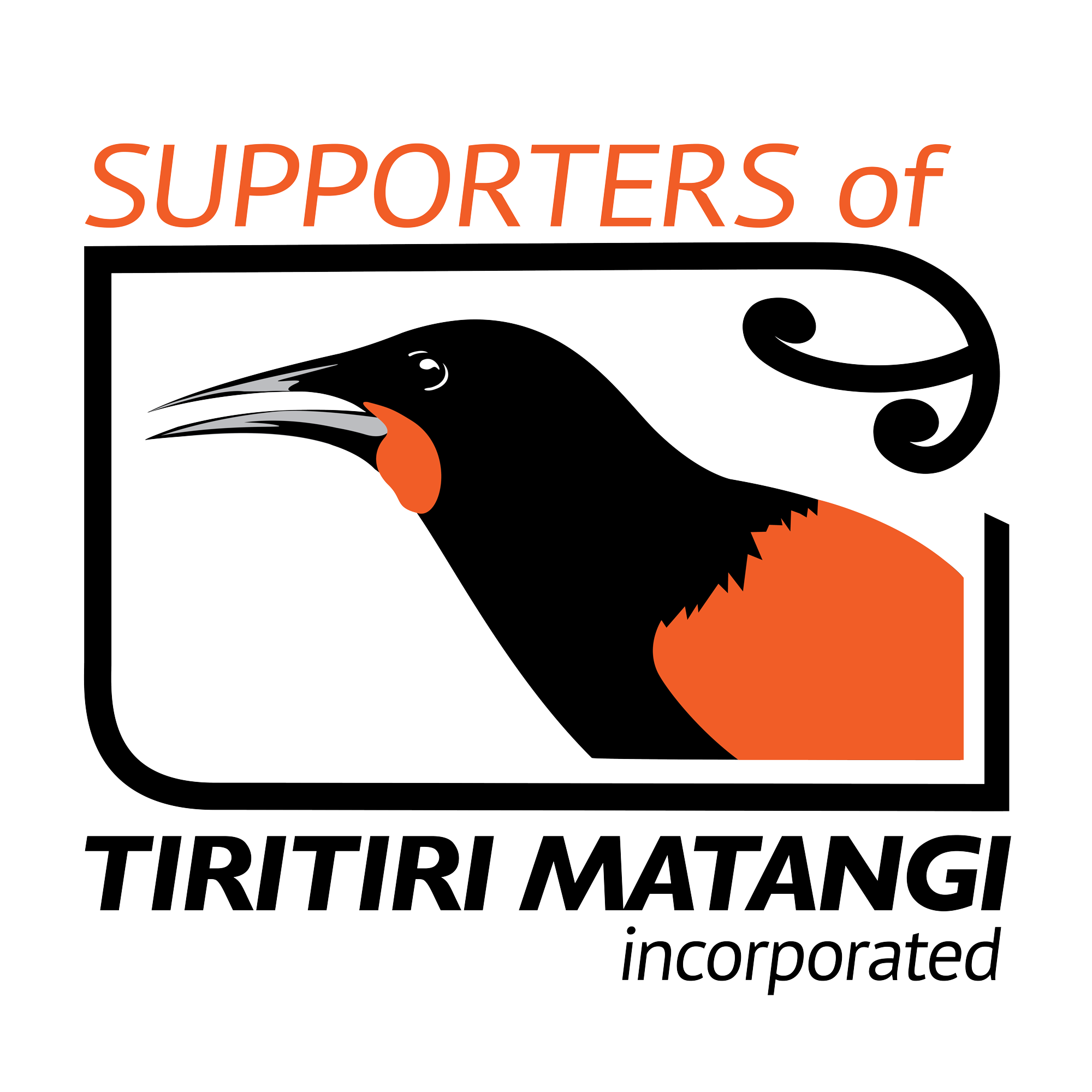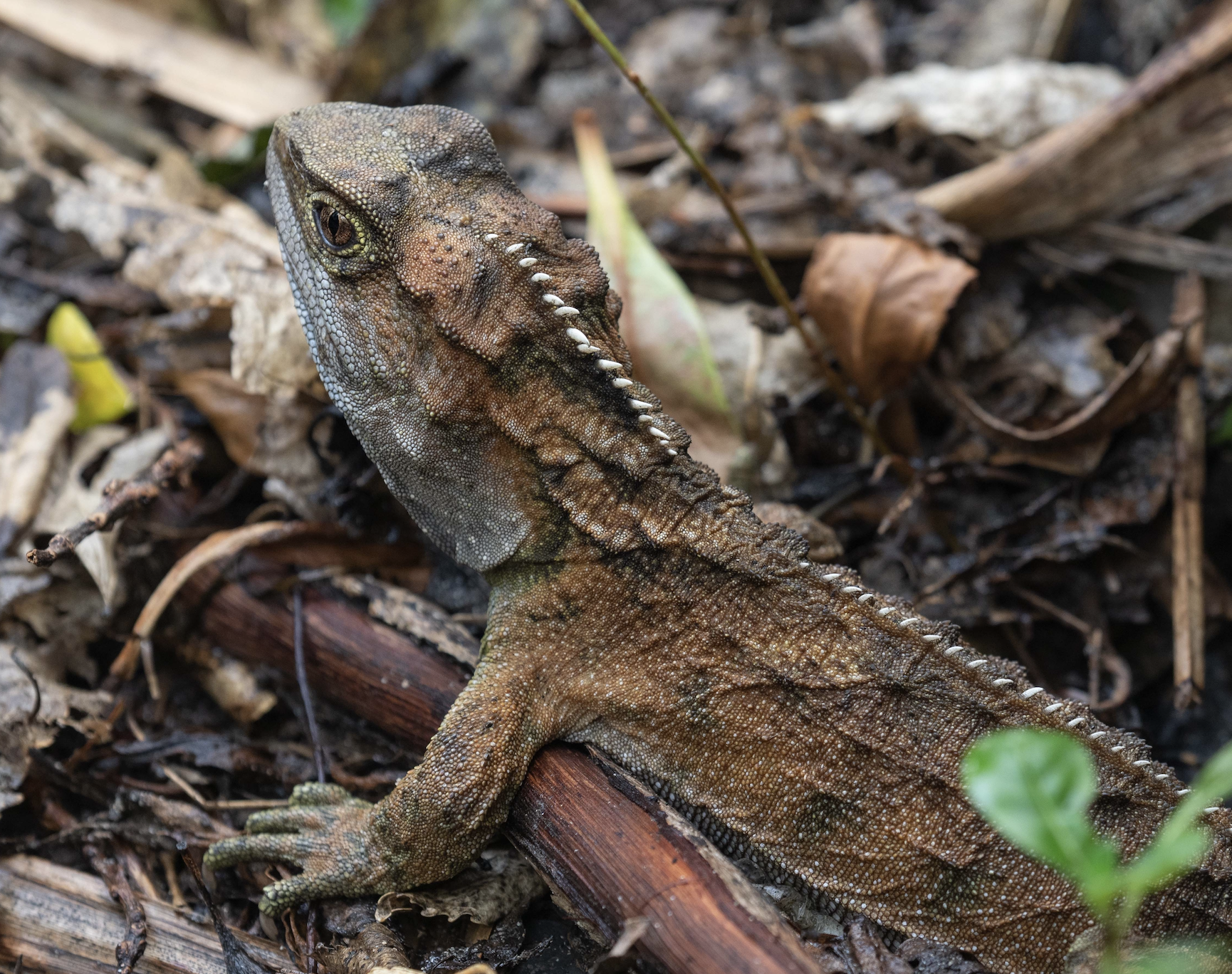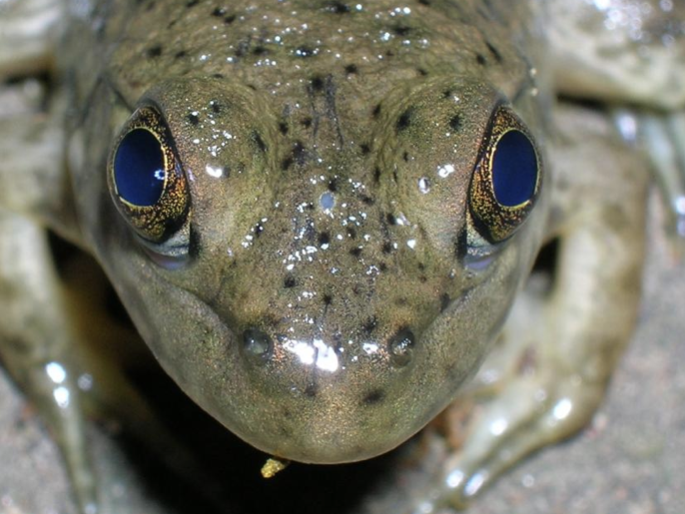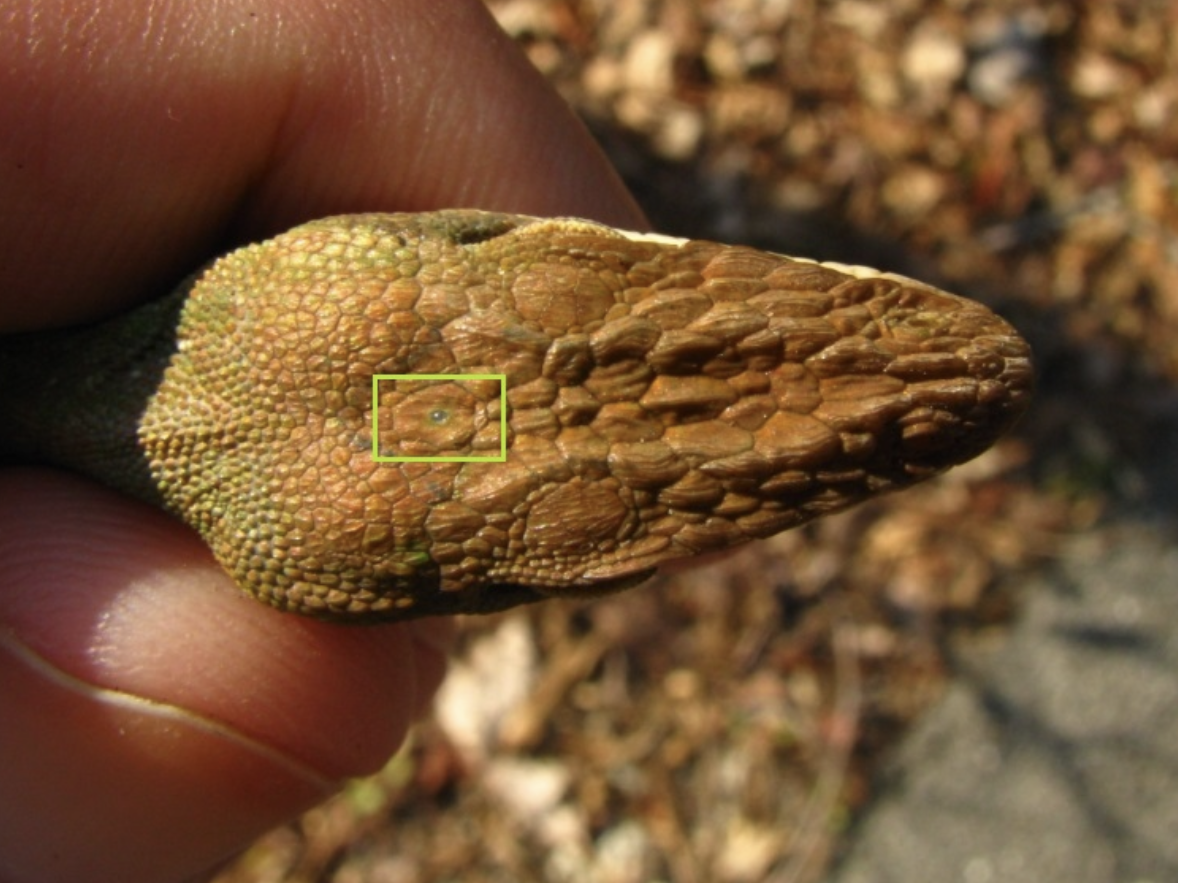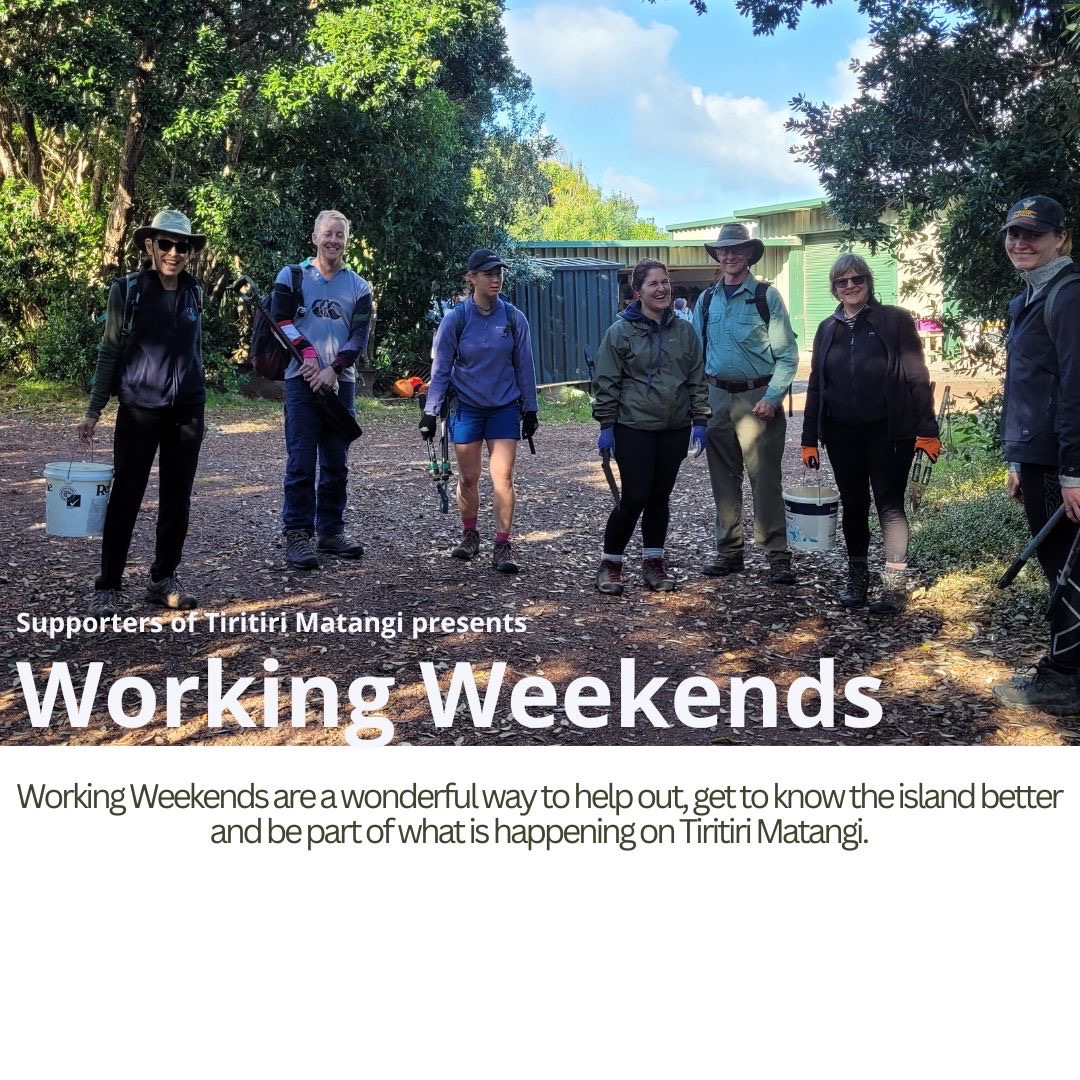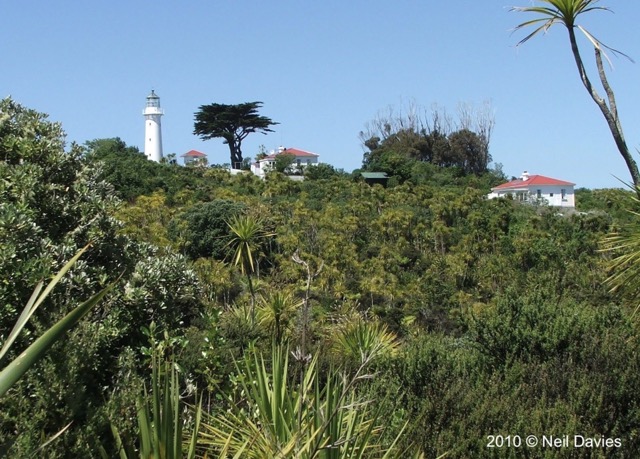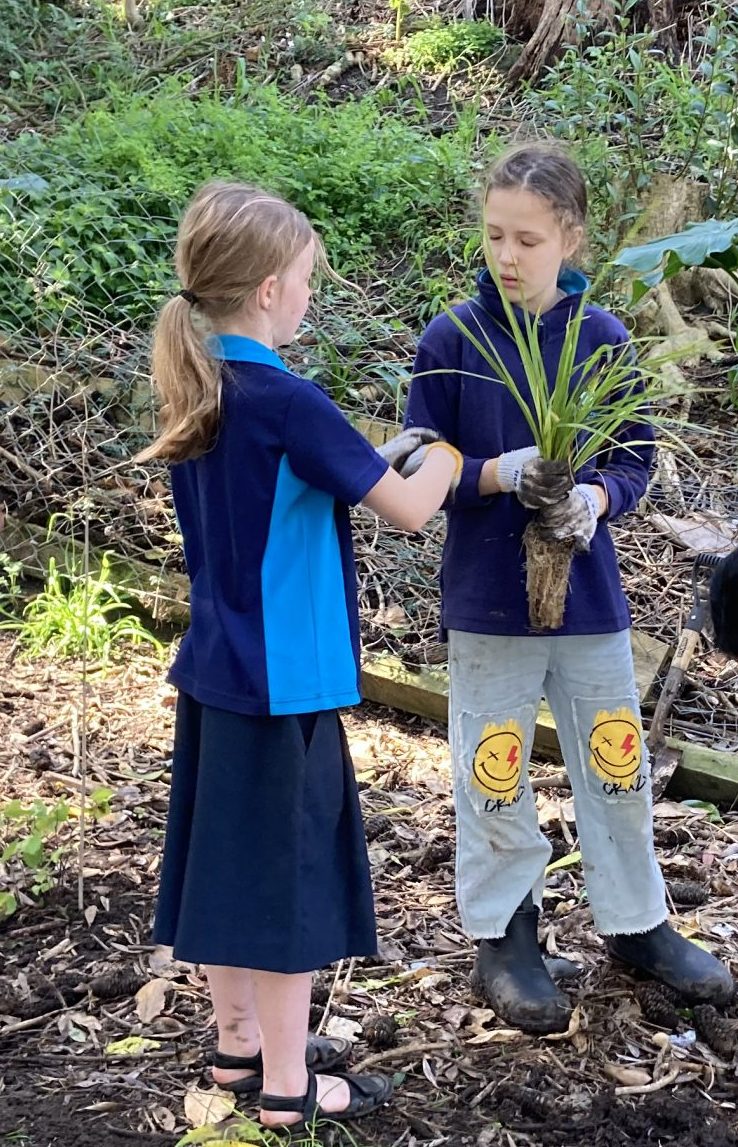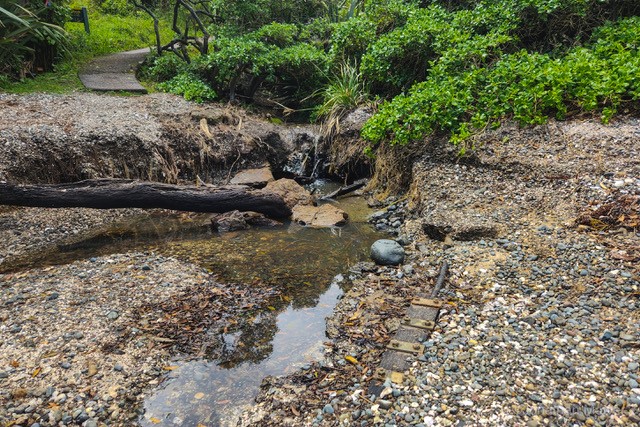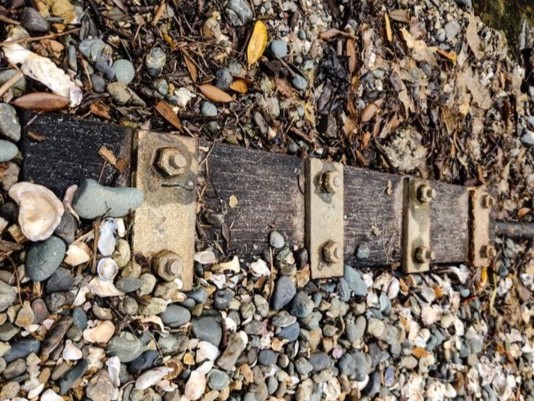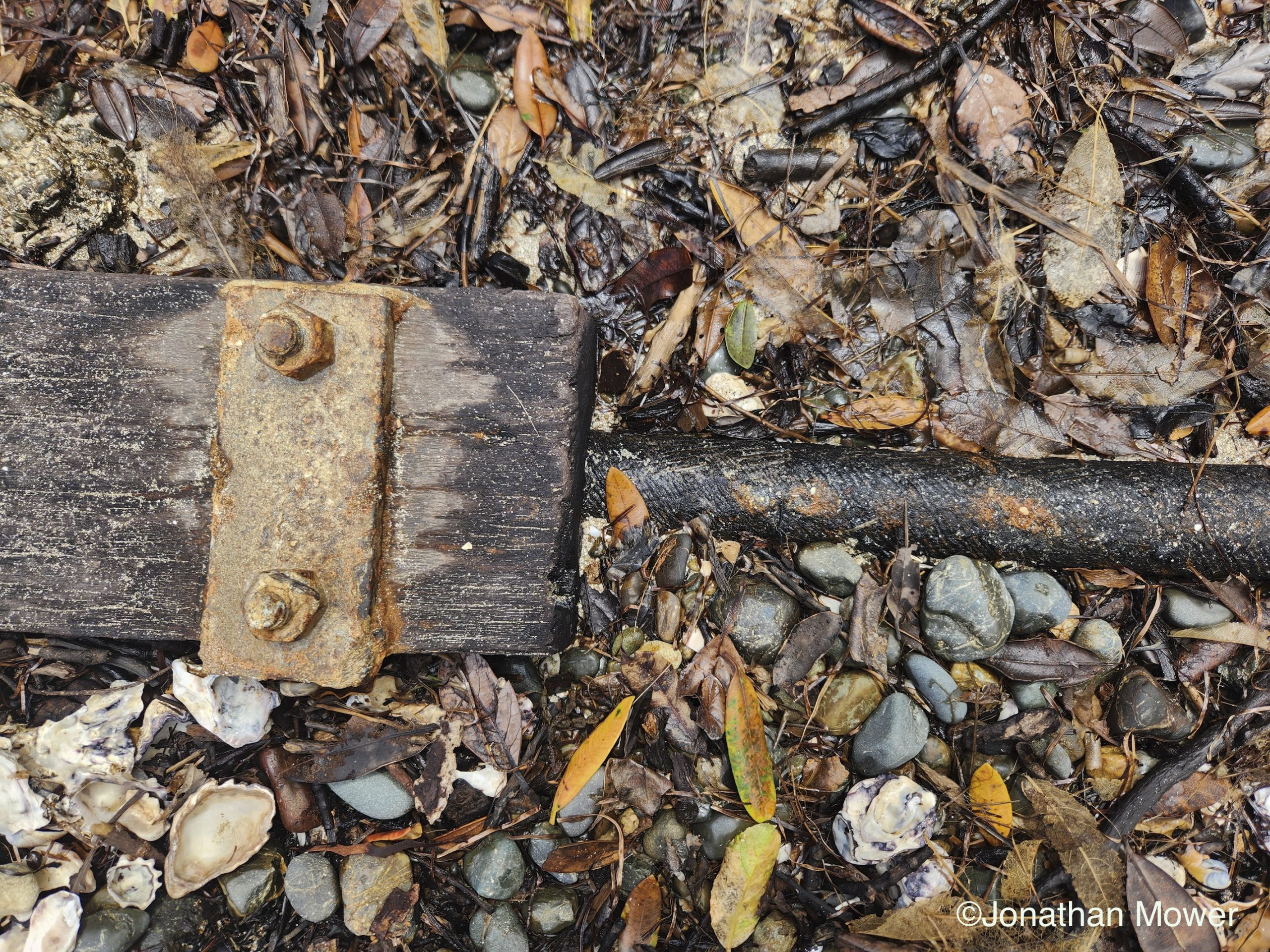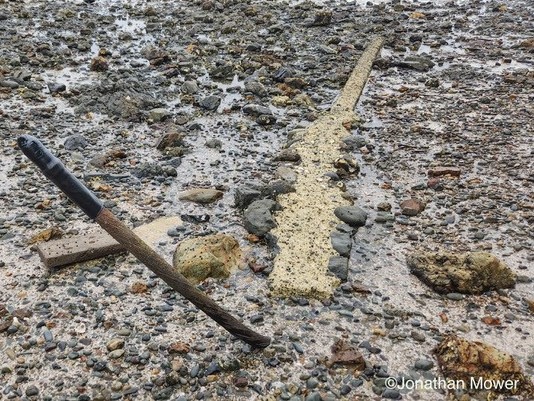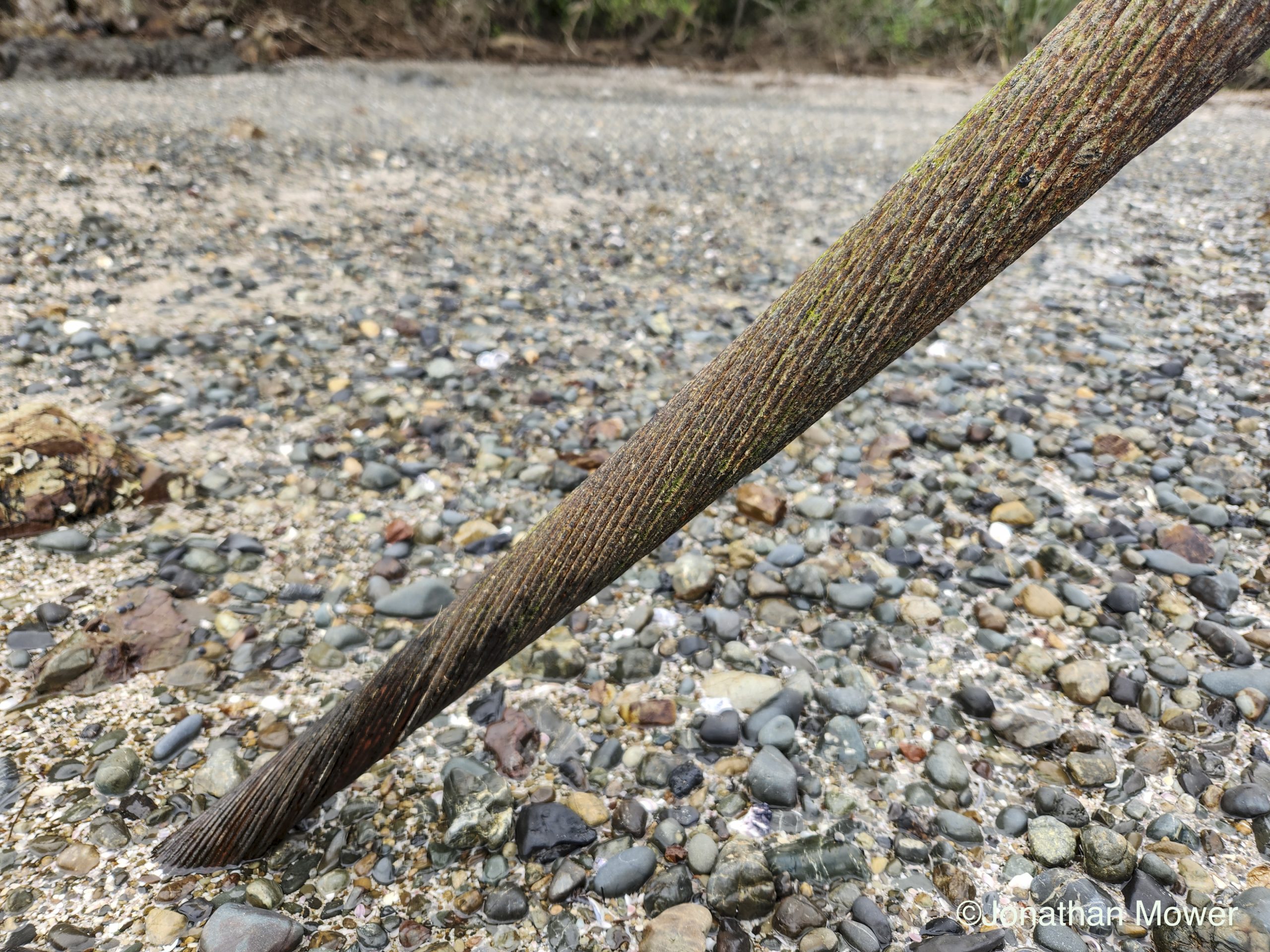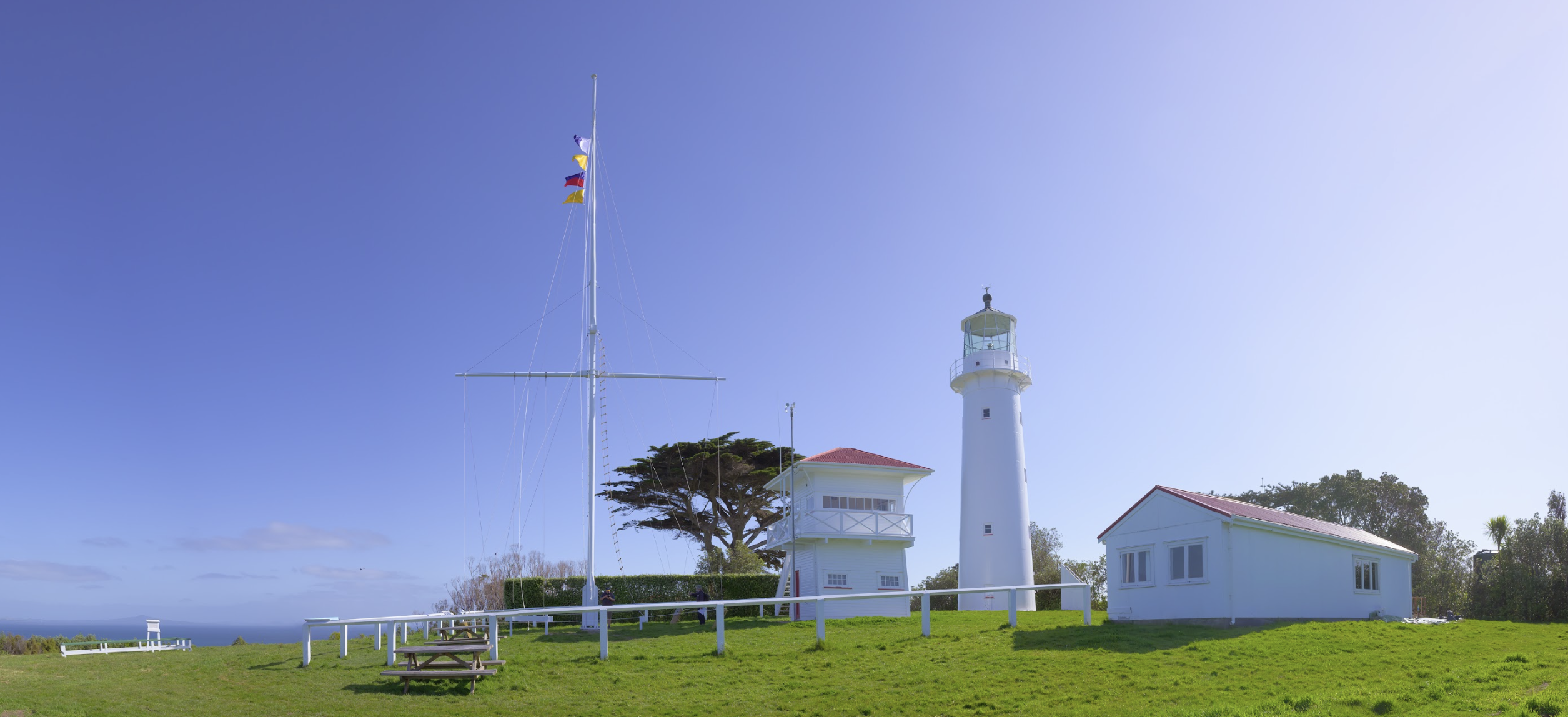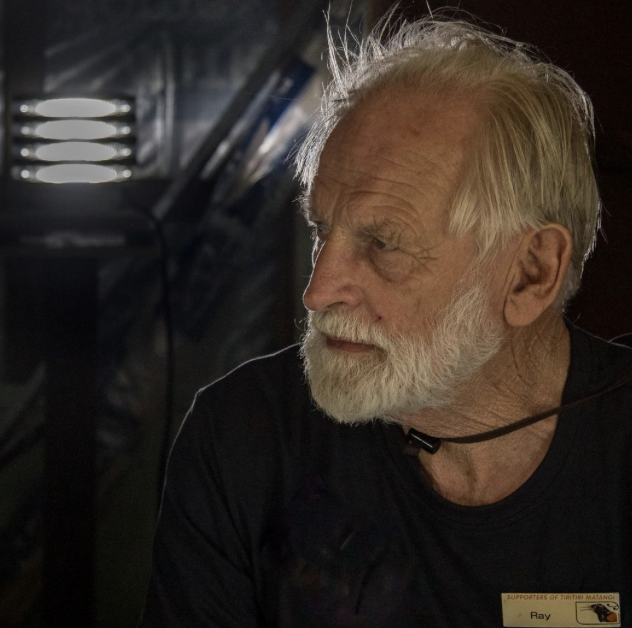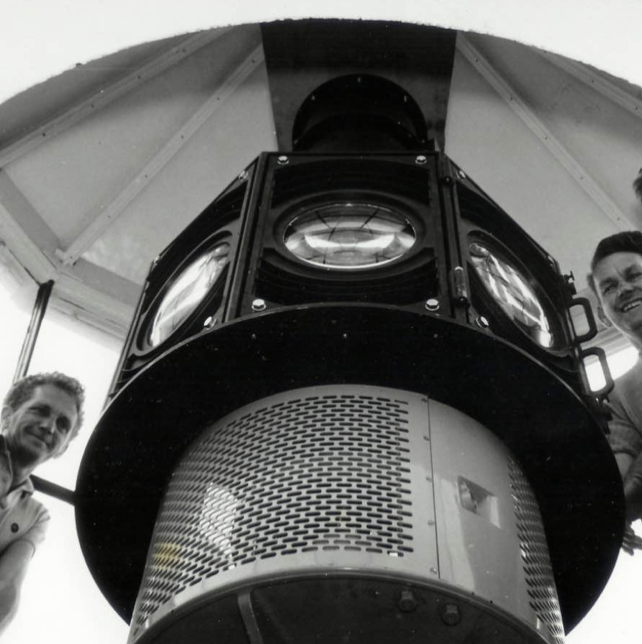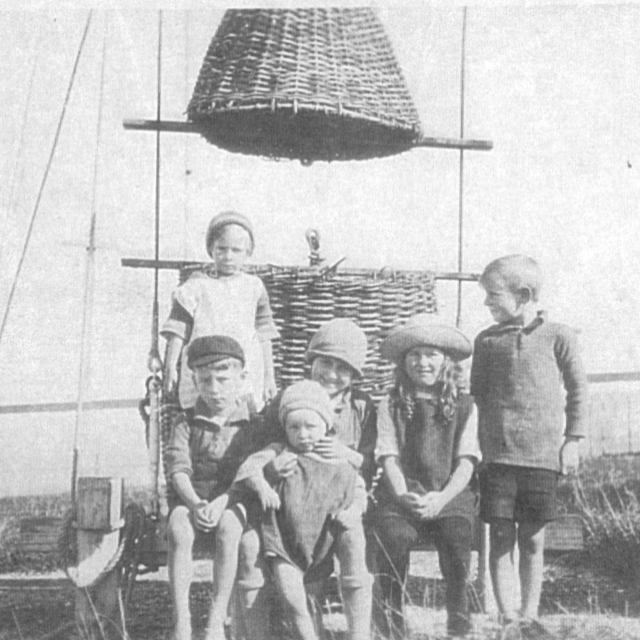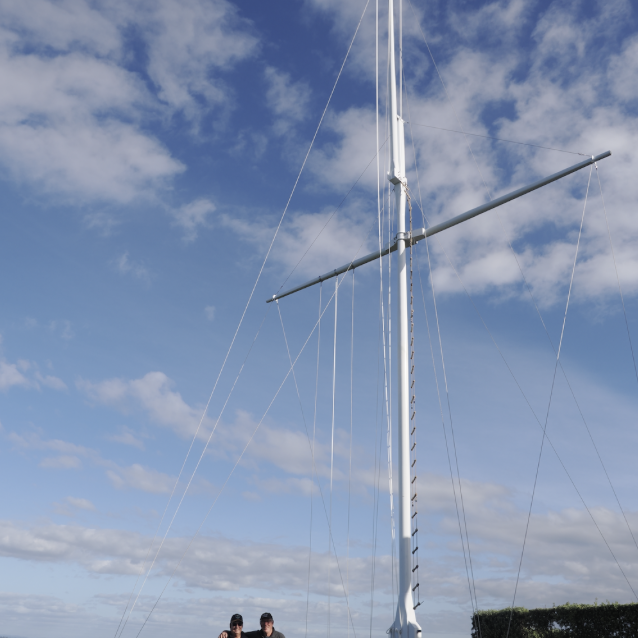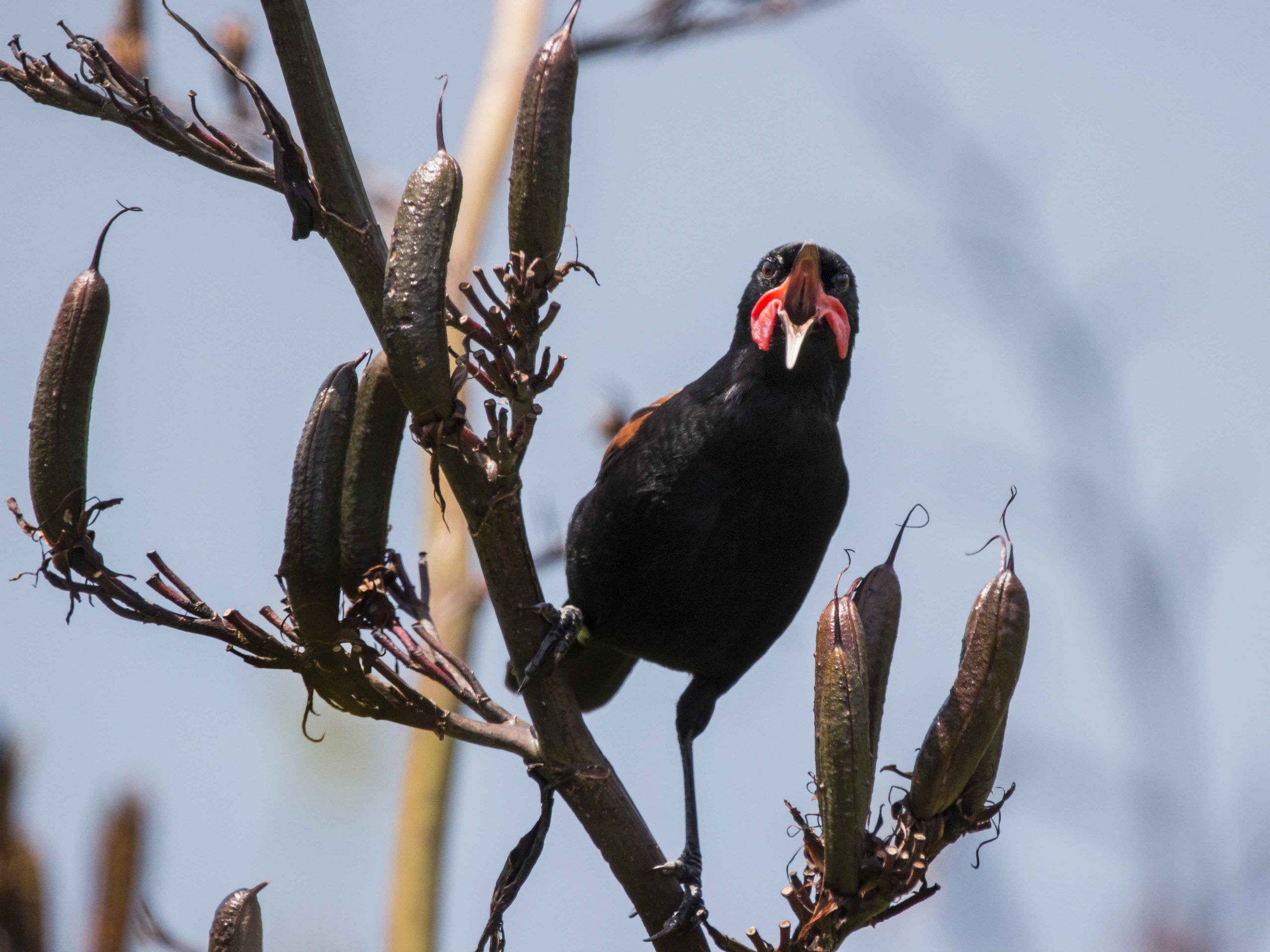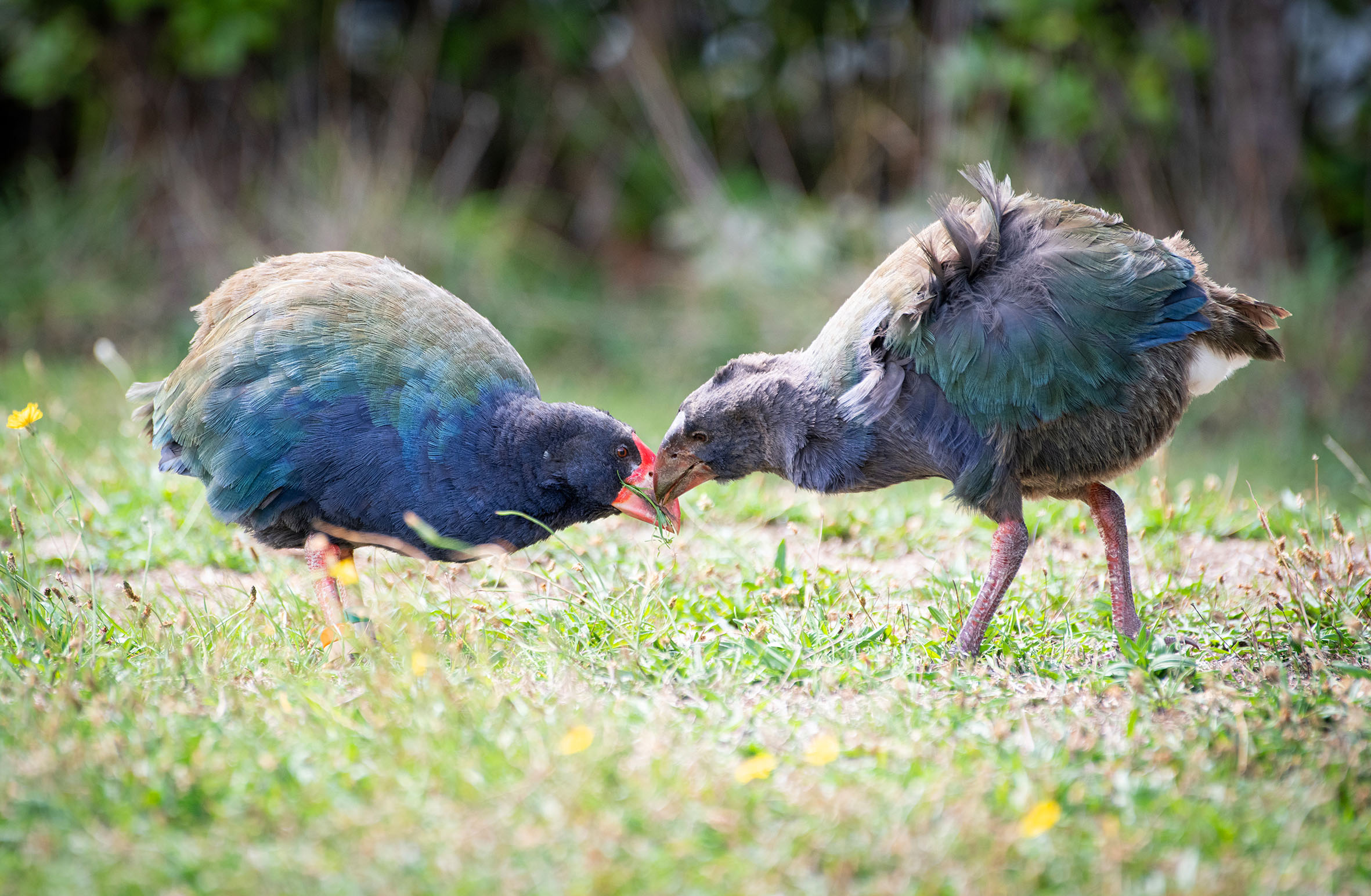Tuatara—a three-eyed monster?
Tuatara - a three-eyed monster?
Author: Malcolm Pullan
Date: May 2024
Header image: Jonathan Mower
When I was a child, I remember my dad telling me that tuatara had three eyes, with the third one on top of its forehead. I can still see the way my dad pointed to his forehead when he said that. I didn’t know what to make of it then: My dad often told outlandish stories. Was this one really true? Over the years when I saw tuatara at zoos, I would look at the top of their foreheads searching for that third eye. I couldn’t see it, and so I became a skeptic.
When I became a guide on Tiritiri Matangi a few years ago I remember some other guides mentioning the third eye of tuatara. They said it in a way that made it seem like it was a unique oddity of a unique living fossil as if it were something only tuatara had. It all seemed fanciful so I set about finding out for myself and what I discovered is that the truth is even stranger than the hype.
First, then, some basic facts. Tuatara do indeed have a third eye—complete with a lens and retina (i.e. with cells that detect light). This eye is positioned in the middle of the forehead, behind a small hole in the skull. My dad was right after all! Tuatara really do have a third eye in the middle of the forehead. It’s called the parietal eye (pronounced pa-rye-e-tal) (1). So why can’t we see this eye? It turns out the parietal eye is covered from birth by a layer of translucent skin, plus possibly some small scales. Scales grow as the tuatara ages and hide the presence of the eye.
But there’s more. The nerve from the parietal eye connects to a gland deep within the tuatara’s brain called the pineal gland. This gland also has cells that detect light. What is the purpose of that you may well ask? What’s the point of being able to detect light directly deep within the brain? Indeed, what’s the point of an eye if it’s covered up with scales and skin? And what’s the point of the eye and gland—collectively known as the pineal complex—in the first place, irrespective of whether it’s covered up or not?
This is where the truth becomes stranger than the hype. It turns out that the tuatara is far from unique in having a parietal eye. Many other vertebrates (2) have a parietal eye as well! Examples include most lizards, frogs, sharks, and some fish (see photos below). In tuatara the parietal eye is particularly well developed, but even that’s not unique. The parietal eye in some lizards (3) is at least as well developed as that of tuatara, if not more so. In truth there is actually a continuous spectrum amongst vertebrates from no parietal eye at all, to a well-developed one. And even if a vertebrate doesn’t have a parietal eye like the tuatara, it tends to have some form of pineal complex, although this may comprise the pineal gland only without the added eye (4). The latter is the case in birds and mammals (including humans).
Perhaps you’ve heard of melatonin? It’s a hormone in the body that helps regulate patterns of sleep and our general daily body-clock. This hormone is produced by the pineal gland and it’s produced in response to darkness, i.e. the absence of light. In vertebrates such as mammals and birds without a parietal eye, the pineal gland receives the signal for light (or darkness) from the brain, which of course it receives in turn from the normal eyes. In those vertebrates with a parietal eye, such as tuatara, signals for light can come directly from that eye instead. This eye doesn’t need to be good enough to form an image—and indeed it isn’t. All it needs to be able to do is sense whether or not there is light around. It would seem that it doesn’t matter if the parietal eye is somewhat covered. Try putting your hand over your eyes and you’ll see what I mean. You’ll still be able to tell whether it’s daytime or not.
So is the parietal eye in tuatara there to help regulate the tuatara’s body-clock? Possibly; probably. The thing is, no-one has yet managed to confirm this, or indeed confirm much about tuatara’s parietal eye at all (5). What is certain is that the parietal eye in some lizards helps regulate how they bask, i.e. how much time and where they bask in order to adjust their body temperature. It is likely that the tuatara’s parietal eye has a similar function. It might even have the function of helping a tuatara find its burrow again as well. Again this has been observed in some lizards. (6)
So, to summarise: Yes, the tuatara has a third eye but then so do lots of other vertebrates. It’s nothing unusual, it’s just one manifestation of a complex of structures found in most vertebrates that tend to help regulate body-clocks. The tuatara’s parietal eye is particularly well-developed, but it is also well-developed in some lizards as well, so that’s nothing unusual either. The eye doesn’t form complex images, only used to detect the presence or absence of light. To put this into even broader context, many invertebrates, such as insects, have different sets of eyes as well. Like the parietal eye in vertebrates, some of these eyes are also there just to detect light in general for a variety of reasons, rather than to form images. At the end of the day, it could be argued that the system of just having eyes for normal “sight”, such as in birds and mammals, is the unusual thing rather than the tuatara’s extra eye!
So is the tuatara a three-eyed monster? Well, it’s definitely three-eyed, but is it a monster? Definitely not, if by monster we mean something strange or fantastical.
- Or pineal eye.
- Loosely speaking, vertebrates are those creatures most people would call animals. They comprise mammals, reptiles, amphibians, birds, and the various forms of fish (including sharks and rays).
- But not snakes.
- Interestingly crocodiles (and their kin, eg.g. alligators) don’t have a pineal gland at all.
- It hasn’t even been confirmed that the tuatara’s pineal gland produces melatonin, although tuatara certainly do produce melatonin somewhere in their bodies, and it’s reasonable to assume that it’s in the pineal gland, like other vertebrates, such as lizards (the closest living relatives of tuatara).
- The mechanism here seems to be by detecting the direction of polarised light.
References:
Cree, A. 2014. Tuatara: Biology and conservation of a venerable survivor. Canterbury University Press, Christchurch. pp. 424–426.
Kardong, K.V. 2019. Vertebrates: Comparative Anatomy, Function, Evolution (8th ed.). McGraw Hill Education, New York. pp. 610–611, 691–692.
Diagrams from Wikipedia (shared through Creative Common licensing):
https://commons.wikimedia.org/wiki/File:Frog_parietal_eye.JPG
https://commons.wikimedia.org/wiki/File:Anolis_carolinensis_parietal_eye.JPG
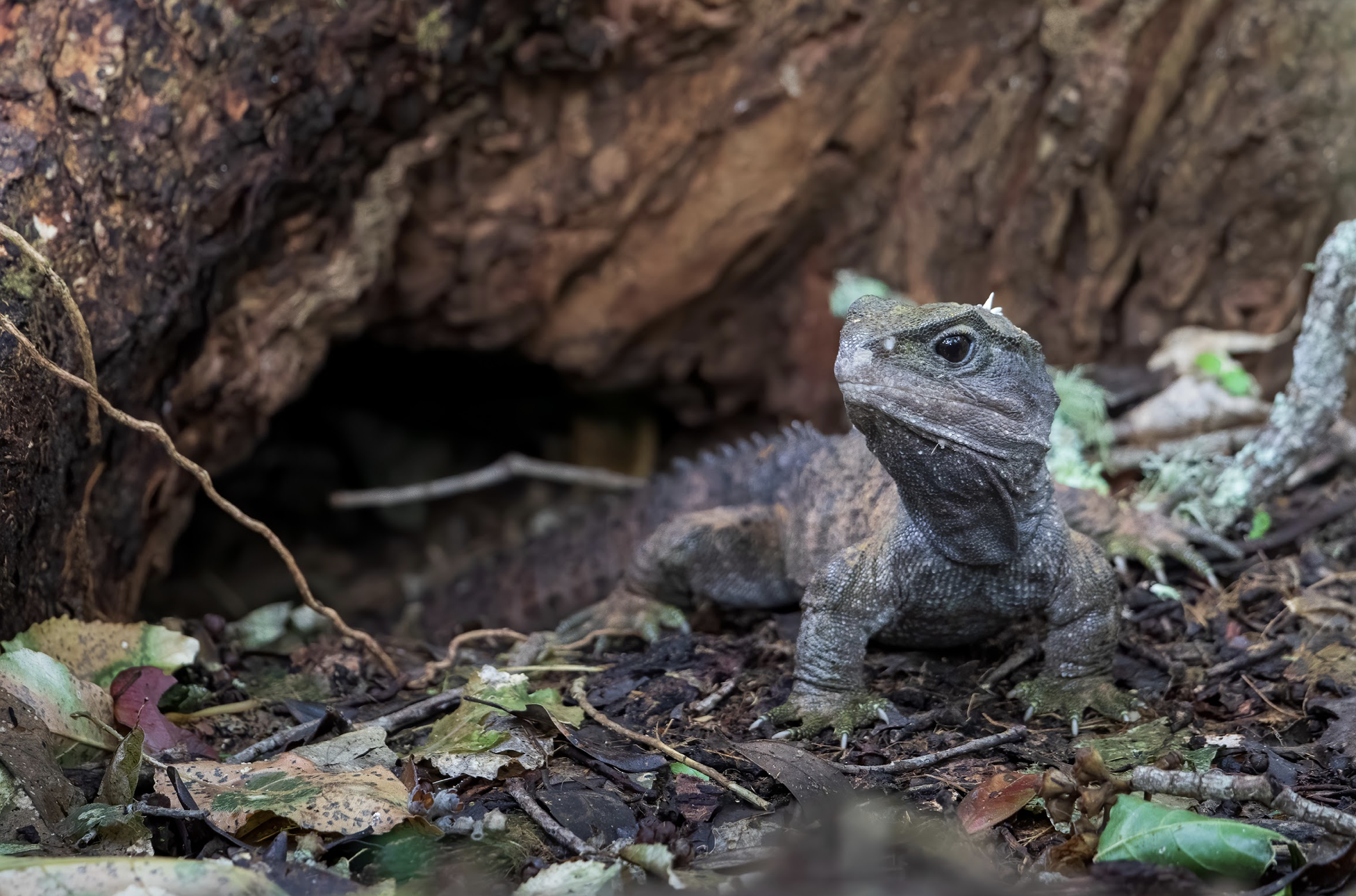
Photo credit: Judd Patterson
Working Weekends
Working Weekends
Working Weekends are a wonderful way to help out, get to know the island better and be part of what is happening on Tiritiri Matangi.
Four times a year on the Working Weekends you have the opportunity to join longer-term large projects such as infrastructure restoration and improvements, building and track upgrades and maintenance, and occasionally, biodiversity enhancements. Or you might find that much needed restorative clearing of tracks is what suits you. There is always a variety of tasks some of which may include heavy lifting and require a good level of fitness however there are also less strenuous tasks for those less energetic.
Many of the working weekenders are regulars who love the sense of contributing to the Island and enjoy the camaraderie in the bunkhouse at the end of the day. Before a shared dinner, you will have time for a walk and maybe a swim. Often after morning, there is the opportunity to hear the birds’ chorus as they greet the sun at dawn.
Hosted by some of our most experienced guides, there are a number of activities held throughout the weekend, including a night walk and a dawn chorus outing.
Working Weekends occur on Auckland Anniversary Day, Easter, King’s Birthday and Labour Weekends. Workdays are 8:00am – 4:00pm with an hour for lunch.
All enquiries and bookings can be made through the Guiding Manager.
Email: booktoguide@tiritirimatangi.org.nz
Labour Working Weekend 2023
Kings' Birthday Working Weekend
Find out more about volunteering
Find out more about volunteering
Supporters Weekends
Supporters Weekends
Come and enjoy an overnight stay on the island and experience the camaraderie of other Supporters on a fascinating night walk and the early morning dawn chorus. You can also join in with one of the guided tours either on Saturday or Sunday.
Explore Group offer half-price ferry fares on application to jenny@exploregroup.co.nz and quote your membership number. The bunkhouse cost is $42 per night per adult, $21 per child up to and including 16 years.
Contact the Guide Manager on shop@tiritirimatangi.org.nz for inquiries or bookings. Please quote your membership number and contact phone number. Your membership must be current at the time of your stay to be eligible.
Dates for 2025
- 8 March
- 5 July
- 6 September
- 4 October
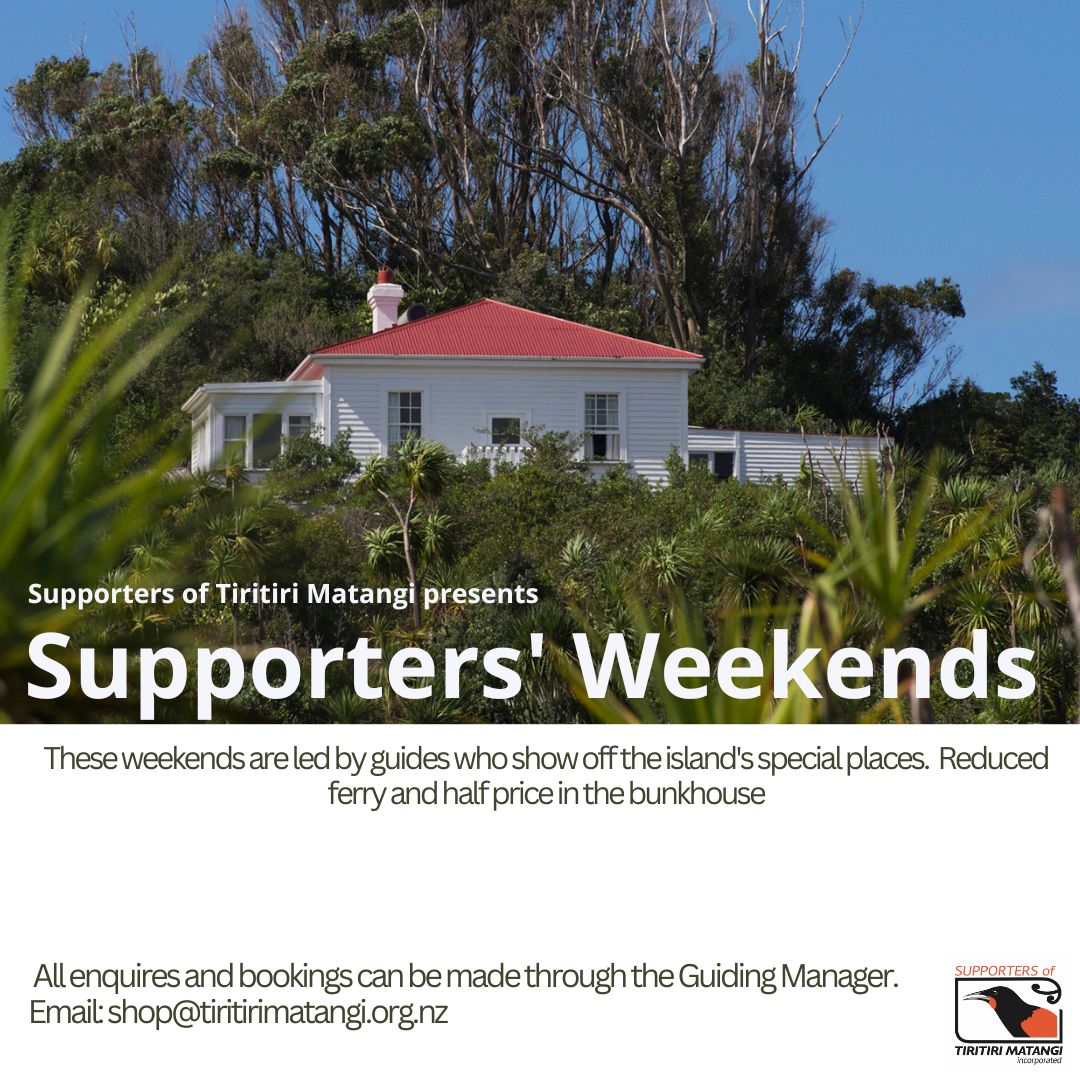
Tiritiri Matangi Talks
Tiritiri Matangi Talks
Our SoTM Tiritiri Matangi Talks are free for all supporters. These talks are held in the evenings in Central Auckland.
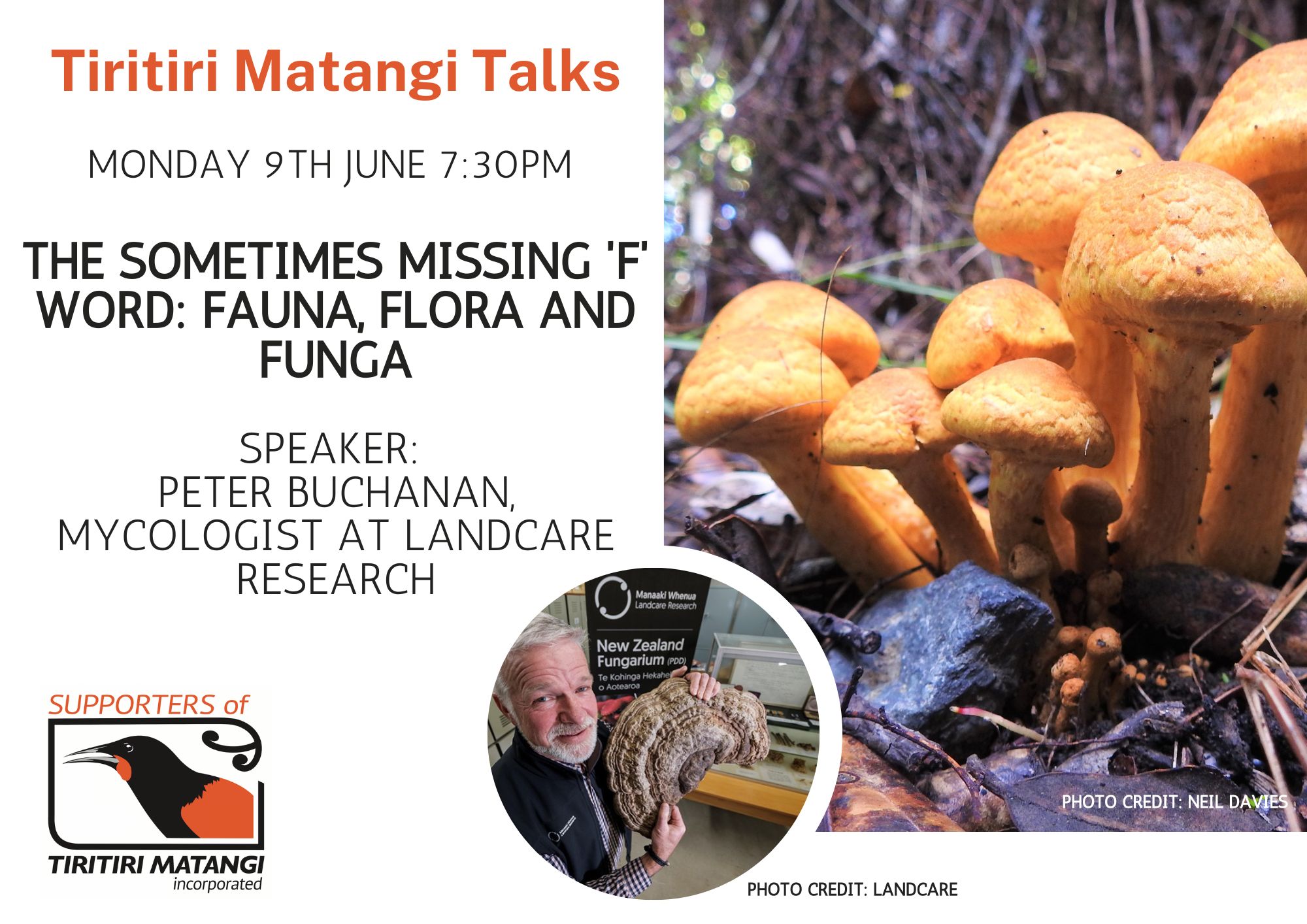
Conservation Awards Winners
SoTM Conservation Winners
2024 SoTM Junior Conservation Award Winner
Kaia Dick Y8 from Whangaparāoa School
Kaia Dick
Year 8 Whangaparāoa School
Kaia is an amazing kaitiaki who works hard to support native plant and animal life. She is part of the school’s pest-free team and weed-buster team and turns up with great enthusiasm and encourages others. Kaia is a great nature ambassador and attends gala days and community events promoting conservation. She is interested in the bird and insect species on Tiritiri Matangi and is inspired to help create a pest-free environment on the Hibiscus Coast.
2024 Winner of the SoTM Award NIWA Science and Technology Auckland City Schools Fair
Eva Yarrow, Year 11 from Mt Albert Grammar
Project: ‘Aphid Attack’
Biological agents are currently a growing alternative pesticide method in NZ agriculture, but methods used by Māori in pre-colonisation agriculture remain underdeveloped. My aim was to test the potential of native plants as biocontrols, by investigating Peach aphids’ reactions to certain plant extracts. I investigated the biological control effect of four natural plant extracts, Kawakawa, Manuka, Kumarahou, and Horopito, comparing aphid’s migration patterns when exposed to these extracts compared to those who have been exposed to modern pesticides. After a 24-hour observation period, I discovered that Kawakawa and Horopito have the potential to repel aphids.
2023 SoTM Junior Conservation Award Winner
Wanika Chetty Y8 from Manurewa Intermediate
Wanika Chetty
Year 8 Manurewa Intermediate School
Wanika was one of the very first students to sign up to her school’s Nature Club.
She is one of the best Eco Councillors with helping in the gardens, with the animals, running our trapline, composts, fruit kitchen, rubbish system, mentoring the Year 7s, and does the yuck jobs and always with a smile on her face! She is one of the best Eco Councillors, who through her commitment and passion for nature has made this Nature Club a success.
2023 Winner of the SoTM Award NIWA Science and Technology Auckland City Schools Fair
Rosie Bilkey, from St Kentigern Girl's School
Project: ‘Weather Versus Water’
My project was on measuring the relationship between rainfall and water quality (including nitrate levels) in my local stream.
“more information to come”
2022 SoTM First Equal Junior Conservation Award Winners
Maddison Smyth Y8 from Northcross Intermediate & Tyler Griffiths Y6 from Summerland Primary
Tyler Griffiths
Year 6 Summerland Primary School
Tyler represents the future of success of our young rangatahi in conservation-he is highly motivated and earnest in his quest to show kaitakitanga for the environment and respect for our precious native species.
As a young conservationist Tyler is committed to taking personal action to protect and restore the environment in any way he can. His teachers have seen his enthusiasm and dedication from a very early age as he shared his thoughts, ideas and actions with those around him. He has become a role model for his peers in the humble and enthusiastic way he has applied himself to action in the environment. Students want to be around him and learn from him and take the lead from him. (He has been an ”influencer” long before it became fashionable on social media!)
Maddison Smyth
Year 8 Northcross Intermediate
Maddison has been an outstanding member of our school Enviro Group for two years. In that time she has attended weeding workshops, visited a native tree nursery to gain skills for propagating seeds and caring for seedlings. She is currently managing a tracking and trapping group for both our school ngahere and the Northcross Reserve council land. Maddison often guides younger members of our team when working in the Reserve.
2022 Winners of the SoTM Award NIWA Science and Technology Auckland City Schools Fair
Cassidy Foster and Mackenzie Leighton, Year 8, from St Dominic's Catholic College
Project: ‘Less Pests, More Birds?’
The project aims to establish whether there is a connection between the amount of pest control and the number and variety of native birds in an area. We wanted to test whether pest control is actually a worthwhile project, and our results were very positive!
We went to 3 different locations with varying levels of pest control, from Kitekite falls track where there is no current pest control, to Tawharanui with its extensive pest control efforts including a pest fence surrounding the sanctuary.
We found with increased the levels of pest control the number and variety of native birds present increased drastically. We tested this by doing a series of bird counts in different locations around our chosen area to get as accurate a picture as possible.
We hope that our project can inspire people to continue or begin pest trapping of their own, and increase support for pest control initiatives such as Ark in the park (our 3rd test site), Tawharanui, Tiritiri Matangi, and many others throughout the country.
2021 SoTM Junior First Equal Conservation Awards
Eve Dale Y2 from Edendale Primary School & George Willans Y6 from Summerland Primary
Eve Dale
Year 2 Edendale Primary School
Eve is an influential environment leader because she approaches all her environmental tasks with great spirit and initiative. She is an inspirational role model to others. She volunteered to go on What Now for a segment on how to reduce waste.
Eve offered tips on; how to cook popcorn from scratch rather than buy plastic covered food like chips and how to use soap bars instead of liquid soap. She fronted this segment like a STAR with lots of her own flair! Eve is a passionate member of the local Eco-Neighbourhoods group and helps out flora and fauna at home by making bird feeders and doing gardening.
George Willans
Year 6 Summerland Primary School
George Willans became part of the ‘Summerland Primary School-Mammalian Predator-Free team’ as a Year 5 student in 2020. In the years before joining the team, George’s teachers had already noted his passion for the environment.
Soon after joining the school team, he started reporting back to their meetings and sharing the steps he was taking to implement predator control in his own patch and beyond. It was obvious that George was on a mission- one of his own making. He is quietly ambitious about making a difference, one rat, mouse or stoat at a time
2021 Winners of the SoTM Award NIWA Science and Technology
Auckland City Schools Fair
William Nand and Aria Holland - Year 8 Kings School
Project: ‘Tūī Tunes’
The students carried out a practical inquiry that unveiled many interesting discoveries in how the area a tūī lives in affects its song when looking at rural, urban and city park environments. Alongside this, it was found that temperature and time of day significantly affect trill, average dynamics, loudness range and volume.
The results show that the lower the temperature at recording sites, the greater the average trill/ minute and the loudness range (LU). Differently, the higher the temperature the greater the average dynamics (LU) of song.
The students found that the earlier the time of day, the greater the trill/60 seconds, volume, loudness range and average dynamics was 15 trill in song, while from 12-15 pm there was an average of 7 trill.
2020 SoTM Junior Conservation Awards
Dylan Lewis
Year 7 Mahurangi College, Warkworth
After a visit to his school from Forest and Bird, Dylan decided to support his community by trapping rats, mustelids and possums in his local area. He began trapping at home in 2018 and then, after discussing with his neighbours, he began trapping in his local neighbourhood from October 2019. He has also volunteered in 2020 to be a part of the trapping team working in the Mahurangi College Bush restoration project.
Dylan initiated trapping to save the dotterel population at Snells Beach and shared his story with the class and in his previous school of Warkworth Primary School. He has assisted Michelle Mackenzie with dotterel protection in Snells Beach. Dylan volunteered to assist with the trapping team in the working in the Mahurangi College Bush restoration project. Dylan traps for his local community, his school community and he assists in local conservation projects when he is able.
2020 Winner of the SoTM Award NIWA Science and Technology
Auckland City Schools Fair
Amelia Simmons
Year 8 Michael Park School, Ellerslie.
Project: ‘Bright Wings’ A study on Butterflies
Amelia chose to do a project on Monarch Butterflies when at home during lockdown. She could study them more closely than when being at school. She loves Monarch Butterflies in that they stand out from so many things due to their striking colours. Each one she looked at seemed to have a different personality: some were shy, quiet and others were on the go the whole time
2019 SoTM and Fullers Junior School Science Award
Ethan Raymond
Year 8 Randwick Park School
Ethan has been a hands on member of the Enviro-Warriors team since its beginning four years ago. He has taken on the role of leader, remembering to ‘do’ the litter-free area award audit prior to full school assemblies, mentoring a younger student to learn the role.
He is proactive in bringing up environmental issues as they arise around the school and poses solutions. He has been instrumental in the success of our orchard by feeding the trees worm castings and mulching. He has attended an after school pruning course at the Auckland Botanical Gardens. He has been a great asset to our enviro programme and in building sustainability awareness within our learning community.
2019 Winner of the SoTM Award NIWA Science and Technology
Auckland City Schools Fair
Abby Haezelwood
Year 8 St Kentigerns Girls College
Project:’ Plastic Beaches’
Abby Haezelwood with her winning Science Exhibit on Plastic Beaches at the NIWA Taihora Nukurani Auckland City Science Fair in September 2019. Amy looked at nine beaches around Northland and Auckland analysing the plastic present. Her exhibit was displayed at the Visitors Centre on Tiritiri Matangi.
2018 SoTM and Fullers Junior School Science Award
Gabriel Barbosa
Year 5 Summerland Primary School
Gabriel is an incredibly enthusiastic member of the Mammalian Predator-Free team at Summerland Primary School. Gabriel has been instrumental in setting up a programe to track, map and trap invasive mammalian predators at our school.
Every week throughout the year he has met with the other team members and his passion for the project has never lessened. He shows commitent to learning as much as he can about ways to protect our native bird species in particular and his enthusiasm is infectious-whether he’s making tracking tunnels and bird feeders or explaining to other students aspects of biodiversity relationships.
2018 Winner of the SoTM Award NIWA Science and Technology
Auckland City Schools Fair
Annika Lints
Year 8 Kohia Terrace School
Project: ‘Are Mussels in Hot Water?’
In this project Annika investigated if mussels could filter the water in different temperatures above and below the average saltwater temperatures. From the results she discovered that mussels filter through any temperatures but the coldest temp (11⁰C) took the longest and at the warmer temperature (23⁰C) was the shortest filtering time taken.
Bringing light to part of Tiritiri Matangi history
Bringing light to part of Tiritiri Matangi history
Author: Jonathan MowerDate: 23/04/23
On January 1, 1865, the new and then richly red Tiritiri Matangi lighthouse first shone its light over the Hauraki. Although that light has been continuously operational since that day, how the light has been generated has changed many times. First lit by colza/canola oil, it changed consecutively to using paraffin, and acetylene, then to electricity first from diesel generators, then from a cable link to the national grid, then reverted back to diesel generators and ultimately to solar power with diesel generator backup as it remains today.
Cyclone Gabrielle and other weather events in February caused deep scouring to parts of the island’s coastline and in doing so brought to light part of this history when it uncovered parts of the submarine cable that in 1967, linked the island to the national grid and ended years of diesel power generation. Laid across the sea bottom, the cable stretched in a loop from Pink Beach near the end of Whangaparaoa Peninsula, across Whangaparaoa Passage to Tiritiri Matangi Island where it exited at the northern end of Hobb’s Beach and travelled inland.
Although the laying of the marine cable was said to have required meticulous planning but it went without a hitch,’(1) maintaining the power connection was not so simple. Marine cables are prone to be damaged by fishing boats and other vessel’s anchors and Tiritiri Matangi’s cable proved no exception. Sometimes the damage would cause cable failure and for Tiritiri Matangi, this was a serious issue as it meant a loss of power not only to the island’s facilities but also to the lighthouse which required an urgent switch to backup generation. Recently Ray Walter, the island’s last lighthouse keeper, recounted one such failure that he discovered while milking. “I was milking the cow, and the cups kept falling off, so I went and had a look, and we had lost one of the phases from the power.”
In 1989, after the cable had failed for the third time, the island was removed from the national grid, and the island reverted to diesel generator supply where it remained until 1990, converting to solar power generation with diesel backup as it remains today. This was not the first cable to connect Tiritiri Matangi to the mainland, however, a marine telephone cable was laid from Waiwera to the island in the mid-1880s using funds donated by Auckland businessmen. Terminating at a small glass, octagonal-shaped phone booth with a curved pagoda-shaped roof, sited on the slopes south of the lighthouse. The telephone line linked the island to the mainland until not long after 1928 when it was lost in a storm. Sourced “Tiritiri Matangi, A Model of Conservation” 2009, by Anne Rimmer.
(1) Jack Gladwell, ‘Mains Power to Tiri Tiri Island’, Ministry of Works Gazette, vol. 4, no. 3, September
1967
Tiritiri Matangi Lighthouse Open Day - TBC
Tiritiri Matangi Lighthouse Open Day - TBC
Take advantage of this rare chance to delve into New Zealand’s maritime history by visiting the country’s oldest operational lighthouse. Climb the stairs for a breathtaking view of the Hauraki Gulf and explore the inner workings of this historic beacon.
Constructing the lighthouse was a formidable challenge, costing £5,747. Builders had to dig through 3 meters of thick, boggy, clay-like mud for four months to reach stable ground suitable for construction. Materials were shipped to the island and then transported to the site on sledges hauled by bullocks over treacherous terrain. Despite these difficulties, the original tower still stands, though the light itself has seen numerous updates since it was first illuminated on January 1, 1865.
The open day is held in memory of Ray Walter, who passed away last year. Ray began his role as the Tiritiri Matangi lighthouse keeper in 1980, during a period when New Zealand was transitioning to automated lighthouses. By 1984, he found himself out of work. However, the Island Conservation Project offered him a new opportunity as a supervisor for Lands and Survey (now the Department of Conservation), and he assumed management of the project in 1985. His enduring impact is evident in the 283,000 trees he helped plant on the island, which have contributed to the lush, diverse forest now covering much of Tiritiri Matangi. Additionally, he was instrumental in introducing various wildlife, including many endangered bird species whose distinctive calls can still be heard across the island, particularly at dawn. Ray and his wife, Barbara, served as DOC rangers for 26 years before retiring from the island’s daily operations in 2006.
Mobility Requirements: Must be physically able to climb steep stairs and confident in confined spaces. Minimum age 7 years old.
To read stories about the maritime history, the lighthouse, and Ray Walter, please click on the images below
Tiritiri Matangi Dawn Chorus
Tiritiri Matangi Dawn Chorus 4th October 2025
This is a unique opportunity to start the day with New Zealand’s original dawn chorus surrounded by native bush and birdlife as the sun rises over the beautiful Hauraki Gulf...
Every spring, the Supporters of Tiritiri Matangi, in conjunction with Explore Group and the Department of Conservation, organise a special early morning ferry for visitors to experience the Tiritiri Matangi Dawn Chorus.
Spring is the very best time to visit the island for the Dawn Chorus – immerse yourself in birdsong surrounded by rare birds and native forest as the sun rises…and with a little luck you may even hear the exclusive kōkako!
Departs Auckland: 4:00am | via Gulf Harbour: 4:55am | Arrives Tiritiri Matangi Island: 5:20am
Departs Tiritiri Matangi Island: 10:00am | via Gulf Harbour: 10:25am | Arrives Auckland: 11:15am
Please be at the wharf 15 minutes prior to your confirmed departure time
7 hours
AGM
Supporters of Tiritiri Matangi AGM 2025
Welcome to the Supporters of Tiritiri Matangi Inc 2025 AGM.
15th September 2025 7.30pm
MinterEllisonRuddWatts Seminar Room, PWC Tower, 15 Customs Street West, Auckland City
A quorum of 30 voting members is required so we encourage members to attend the meeting. However for those unable to attend, but who wish to observe the meeting please use the following information below to join via Zoom on the day.
Online open: 7:15pm NZST
Meeting start: 7:30pm NZST. – Please arrive by 7.15 so we can start promptly at 7.30
Meeting end: 9:00pm NZST (Anticipated)
The Zoom link will be added to this site one week before this meeting
Please Note: The AGM audited accounts will be added to the Reports page.
Notified business is to be submitted to the Secretary at least 5 days prior to the AGM. Please email your submission to secretary@tiritirimatangi.org.nz
2025 Photo Competition
Tiritiri Matangi 2025 Photographic Competition
It is that time of year again when we are looking for entries to our photographic competition (and photos for our 2026 Calendar which raises over $10,000 for the Island).
We have 5 categories –
All photos must have been legally taken on Tiritiri (e.g. drone photos are not permitted) –
- Fauna
- Flora
- Landscape/Seascape
- People on Tiritiri
- Under 16 years Old
You can enter 4 photographs in each category. Please email them as attachments to photocomp@tiritirimatangi.org.nz before April 30th. We will have an independent judge from the NZ Photographic Society and all photos must be able to be used for the promotion of Tiritiri Matangi.
To help us enter your photos:
1. Photos can be any size & must be attached to the email (not just copied) – 1 to
5MB is good. It’s OK to send several emails. (.heic files cannot be accepted)
2. Photos should not be zipped
3. Please save the photos with a name:
AA CC XXXXXXX
CC = category
FL Flora/plants
FA Fauna/animals
PE People
LS Landscape/seascape
YP Under 16
XXXXXX = Photo description (e.g. Tui, Hobbs Beach, kowhai, flower)
For example, if Jenny Smith took a photo of a bellbird: JS FA Bellbird
Peter Topp had two kowhai flower photographs: PT FL Kowhai 1; PT FL
Kowhai
Condition of entry The Supporters of Tiritiri Matangi Inc (SoTM) acknowledges that photographers own the copyright in their images in accordance with the NZ Copyright Act 1994. It is a condition of entry that you grant SoTM limited free use of your images in accordance with our new Image Use Policy which restricts usage to SoTM purposes only including for our calendar. Full details of this new policy are available on our website @ https://www.tiritirimatangi.org.nz/image-use-policy/
